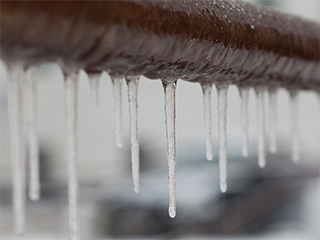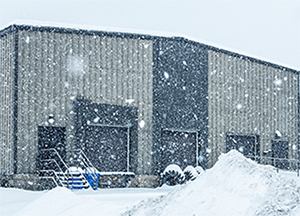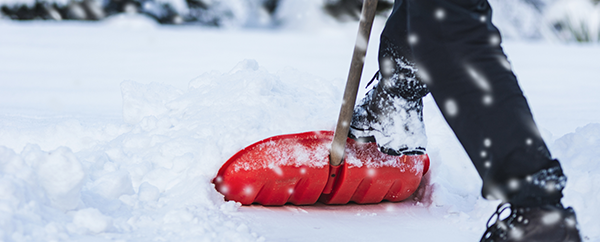How to maintain adequate building temperatures and monitor a roof’s snow load
This article was originally published on Zurich Insights and is reused with permission.
- Winter weather creates a variety of hazards for commercial buildings, from frozen pipes to collapsing roofs.
- Learn steps to take to prevent pipe freeze-ups with heat loss monitoring, paying attention to specific areas where typically temperatures are lower.
- Follow these steps to monitor your roof’s snow load to prevent damage: how to measure snow load, using a roof-deflection monitoring system and more.
Just as wildfire and hurricane seasons draw to an end, the calendar brings us around to another natural disaster threat: winter storms. And while research may support casual observations from region to region that it doesn’t seem to snow as much any longer, that can be misleading. In fact, though southern regions in the U.S. are seeing less snow, northern states have seen a significant increase in snowfall over the past 50 years.
For business owners, such record-breaking storms as the February 2021 blizzard that hit many parts of the country may stand out as especially damaging. Yet the increase in snowfall totals and the fact that climate change has increased the amount of moisture in the air, and thereby the potential for greater precipitation amounts, means that a severe winter weather threat is ongoing, not just a once-in-a-generation anomaly.
Two key threats for businesses are freezing in a building’s water supply system and potential damage to rooftops and whole building structures from snow accumulation. Winter weather threats require a thorough and regularly updated Emergency Response Plan (ERP), and that begins with mitigation that addresses these two elements.
Cold weather freeze-ups
Cold weather regions where temperatures can fall below freezing  present a threat to any building housing water-filled systems. When water supply systems freeze, the ice can develop into significant obstructions that block and damage the systems — from plumbing to steam condensate returns, fire protection systems and chilled water.
present a threat to any building housing water-filled systems. When water supply systems freeze, the ice can develop into significant obstructions that block and damage the systems — from plumbing to steam condensate returns, fire protection systems and chilled water.
Water that freezes in a building’s pipes can impose significant loads that can eventually break pipes, valves and fittings. This secondary impact can lead to further system impairments. Not only must the ice thaw, but also repairs will be needed.
Related: How to prepare your small business for winter
If temperatures moderate and ice plugs thaw before broken pipes are detected, a tertiary impact can develop: Water escapes from the systems and damages the building and contents, potentially causing widespread property damage, business interruption, and irate tenants and customers.
Adequate heat
The key to avoiding freeze-ups is to maintain adequate building heat. A desire to conserve energy should be balanced by keeping a structure’s heat high enough to prevent freezing. The standard temperature to maintain in a building is 40°F (4°C), set by LPC rules. Higher temperatures typically are needed for diesel engine-driven fire pump rooms. (Consult with the diesel engine manufacturer for specific guidance.)
Monitoring heat loss
Monitoring a building at the proper temperature can be a challenging effort. Three methods typically used are:
-
- Normal building occupancy. A simple and reliable approach to monitor a building during normal business hours. However, some normally unoccupied areas of a building may require a special effort to ensure accurate monitoring of heat loss.
- Security patrols. Outside of normal business hours, security patrols can maintain periodic human presence throughout an unoccupied building. Hourly patrols in accordance with National Fire Protection Association standards would be one approach.
- Electronic monitoring. Room temperature supervisory devices may be provided as part of the building fire alarm system. Such devices initiate a supervisory signal when the temperature falls below 40°F. But because these devices are typically installed only at automatic sprinkler system risers, the extent of coverage provided may be limited.
Any one of these methods of monitoring buildings for low temperature has challenges. Overall, there is no substitute for human presence, but few businesses operate around the clock. Similarly, few businesses maintain a security tour service. As for electronic supervision, the number of room temperature supervisory devices is usually limited.
As a result, continuous monitoring of building temperature can be difficult. No doubt this explains a continuing experience with freeze-ups. This underscores the importance of taking appropriate actions to prepare for cold weather, periodically conduct cold weather inspections and have a special action plan when extreme cold weather is expected.
Special attention should be paid to some areas of buildings which tend to have a greater exposure to freezing. They include:
-
- Stairwells
- Lobby vestibules
- Elevator penthouses
- Spaces above ceilings
- Fire pump rooms and houses
- Dry pipe valve closets
In preparation for cold weather, review these spaces. Consider actions such as:
-
- Installing thermometers to simplify periodic inspections. For above-ceiling spaces, provide remote reading thermometers that allow temperature checks from floor level.
- Replacing wet-pipe sprinklers with non-freeze type systems in areas that are difficult to heat.
Up on the roof
If your company owns or operates buildings in a region prone to  snow, each of those structures should have a roof snow removal plan. Having a plan prepared allows for the timely assessment of snow loads and the confidence to know when the costly and potentially dangerous action of snow removal is actually necessary.
snow, each of those structures should have a roof snow removal plan. Having a plan prepared allows for the timely assessment of snow loads and the confidence to know when the costly and potentially dangerous action of snow removal is actually necessary.
Snow removal risks
Significant snow accumulations on rooftops present the potential for overloading and even building collapse. But how much is “significant?” And how do you factor in drifting and other aspects, such as previously accumulated snow? Additional challenges face buildings with parapet walls, photovoltaic arrays (solar panels) or other rooftop equipment installations. These items could result in additional load on the roof due to the effects of sliding and drifting snow. This is when predetermined snow load limits become vital information.
Have qualified contractors on call
If your staff does not include experienced snow removal professionals, ensure you have agreements in place with qualified, trained contractors, ready to begin work as needed. The contractors should be fully trained, familiar with all the safety guidelines you have in place for snow removal, and be properly insured to cover property damage and injury exposures.
Related: Steps to prevent winter property damage to roofs
Creating a safe work plan
Implement a roof snow removal safe work plan that includes the following elements:
-
- Measurement methods to determine actual roof snow loads
- Identification of the design snow loads for each roof
- Incorporation of OSHA fall protection guidelines
- Supply of tools and equipment
- Triggers to implement the plan
- Measuring actual snow loads
For workers, clearing snow can be dangerous. When snow is heavy, removing it is a physically demanding task that creates health hazards such as heart attacks, strains and sprains, and hypothermia.
Related: Loss control tips to prevent winter freeze-ups
In addition, removing snow from a roof is an expensive activity when you factor in workers, fall protection and cranes. There may also be added costs of roof repairs due to any damage that might occur on cold roof surfaces during the snow removal.
A roof snow removal plan should compare the design snow load of a roof to the actual snow load. The design load or total roof strength for a roof is a combination of the
-
- Dead load (weight of the building materials and fixed equipment)
- Live load (from workers, tools and equipment)
- Wind load
- Snow load
These loads should be documented in the design documents for a building. If they are not available, engage a structural engineer to develop them. Take note that snow load knowledge has been evolving in recent years. If the roof design loads are not based upon the current edition of ASCE 7 “Minimum Design Loads for Buildings and Other Structures,” consider having a structural engineer re-evaluate the snow load capacities based upon the current edition.
The design snow load will not be the same for all roofs at a site, and it may even change for various sections of an individual roof. Areas where a roof is exposed to drifting snow should possess higher design snow loads. Drifting snow can be caused by such features as:
-
- Walls of attached or even nearby taller buildings
- Higher nearby terrain
- Parapet walls
- Rooftop equipment
Measuring the snow load
There are several methods to determine the actual snow load on a roof.
1-square foot: A frequently used approach is to collect and weigh all the snow from a 1-square-foot area of the roof. This approach often involves a person going onto the roof to gather the snow sample, however the task poses a risk of injury to the worker collecting the snow.
Smaller sample: Another approach, offered by the National Weather Service, involves collecting a smaller sample of the roof snow from an accessible point, such as near a roof access door, hatch, window, fixed ladder or other safe means of reaching the area.
Snow deflection: Safely removing snow from a roof is an expensive undertaking. If you will be periodically faced with deciding whether or not to clear snow from a roof, it may be cost-effective to consider a roof-deflection monitoring system that can alert you when action is needed. These monitoring systems can provide clear criteria for when it is time to act.
The savings from avoiding one unnecessary snow removal effort may pay for the cost of installing a roof-deflection monitoring system. Examples of companies that can provide roof deflection monitoring systems include:
Analyzing the need
It is essential to evaluate available systems against the criteria of your particular situation. There are several conditions that can increase the need for clearing snow from a roof. They include:
-
- Buildings housing high-value equipment or stock
- Buildings exposed to drifting snow due to roof height changes, parapets or rooftop equipment
- Buildings designed to the 1993 or earlier edition of the aforementioned ASCE 7 “Minimum Design Loads for Buildings and Other Structures,” which are designed to a lower roof snow-load requirement
Tracking roof load changes
Changes to roof loads during warm weather can lead to a surprise during a future snowfall once colder weather returns. Any change that increases the dead load will reduce the available snow-load capacity.
To avoid surprises, your company should implement a change management program to avoid uncontrolled changes that may affect roof loads. Change may have an impact on the roof snow load in two ways:
1. The snow load capacity of the roof may be reduced.
Adding weight to a roof will reduce its snow load capacity. An example of adding weight is re-roofing without the removal of old roofing. Another example of adding weight is the installation of new equipment on a roof or suspending new equipment from the underside of a roof.
2. The snow loads experienced by the roof may be increased.
An example of a change that may increase the snow load experienced by a roof is increasing the amount of insulation in a roof. Whenever a roof system is updated, adding insulation may be required to comply with current local energy codes. Increasing roof insulation reduces roof snow melt and increases the retained snow accumulations.
Another factor that may increase snow load is the addition of an attached or nearby building with a higher roof. The taller building may cause increased snow accumulations on the lower roof of the existing building.
The change management plan for roofs should include a review by a qualified structural engineer based upon the current edition of ASCE 7. The structural engineer can guide any needed structural upgrades and help establish triggers for roof snow removal plans.

